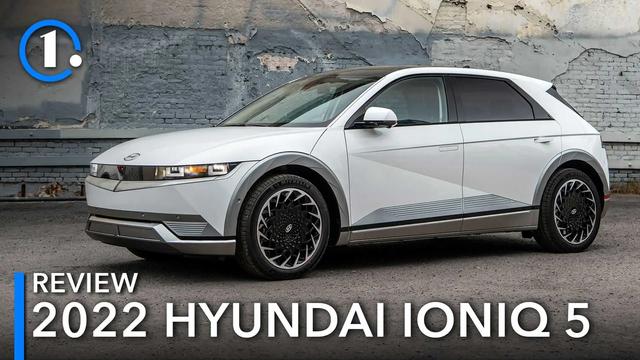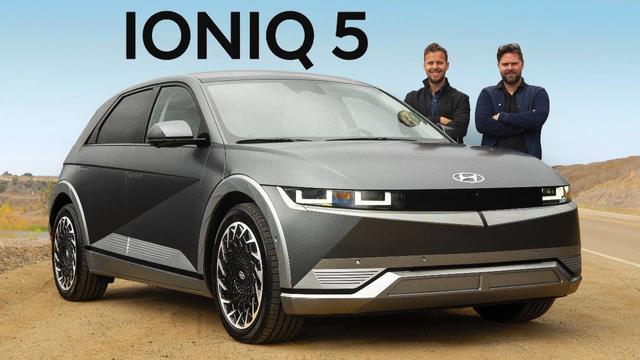2022 Hyundai Ioniq 5 Review and Video
The year is still young – as I type this, we’ve only begun our descent into February’s deep freeze – and yet an early candidate for its most outstanding automobile has already emerged.
The 2022 Hyundai Ioniq 5 ushers in a new era of mainstream electrification – one where reasonable range meets rapid charging capability in a retro-futuristic ride that’s cool instead of quirky. While a few functionality foibles stop it short of perfection, they just might be worth looking past for how well this all-electric car comes together otherwise.
Styling: 9.5/10
Yeah, yeah – to each their own and all that; but few other sub-six-figure cars can turn heads like this hatchback. Now, part of it surely comes down to rareness (about 1,000 have been delivered Canada-wide to this point), but the retro-inspired styling is enough to draw plenty of praise from passersby.
Hyundai says the design is a call-back to its first-ever mass-produced car, the Pony; and while I see more Lancia Delta Integrale, I get the point. The proportions are all but perfect, while crease lines and parametric accents give it modern flair, and the pixel lights front and rear play up a sort of eight-bit video game vibe. In short, I love it.
The interior is an equal blend of the past, present, and future of automotive form and function. The twin 12.3-inch screens that span the dash are all that stand out, with simple shapes and design lines making for an understated space overall. It’s not quite as eye-catching as the exterior, but it’s unquestionably clean.
Practicality: 9.5/10
Where the Ioniq 5’s cabin leans heavily into the next generation is how the space is used, with a distinct move away from tradition. Take the centre console; since there are no mechanical linkages that need to be hidden under a tall plastic tunnel, it sits low between the seats, with space for a handbag beneath the fold-down armrest. What’s more, with the top trim’s optional Ultimate package ($5,000), the entire unit slides forward and back some 140 mm (5.5 in), providing a sort of pass-through between driver and passenger reminiscent of the old bench-seat barges of the ’70s and ’80s.
The rear seats are on rails, too, employing an old but effective trick for prioritizing either passenger or cargo room as required. Space behind the 60/40 split-folding bench maxes out at 770 L, while folding it yields a total of 1,680 L – generous numbers that make the Ioniq 5 almost as useful a larger crossover like the Toyota RAV4 when it’s time to move stuff. Disappointingly, however, the only way to get a cargo privacy cover is by opting for that pricey add-on package. Otherwise, there’s nothing – not even an accessory option – to keep belongings in the back from prying eyes.
Stretching 3,000 mm (118.1 in), the wheelbase is the brand’s longest in its North American lineup, exceeding even that of the hulking three-row Palisade. All that space between the wheels makes for a roomy cabin, as does the width of this car (yes, it’s a car). At 1,890 mm (74.4 in), the Ioniq 5 is wider than the average compact crossover, with good hip- and shoulder room as a result. With the Ultimate package’s fixed glass roof, rear headroom isn’t quite enough for my 6-foot-3 frame to fit, with my head wedged up against the back edge of the window frame; but there’s plenty of vertical space up front, and good legroom all around.
User Friendliness: 7/10
Where my height leads to issues in the driver’s seat is with what I can see – or, more appropriately, what I can’t. The way the all-digital instrument cluster is configured, the speedometer is completely obscured by the steering wheel. Of course, this is something of a unique problem, but tall drivers should take note nonetheless.
Otherwise, the cabin is a model of simplicity, which is mostly beneficial. There’s a selection of physical controls on the dash, as well as a haptic touch panel for climate adjustments. Notably absent, however, is any kind of convenient way to adjust the front-seat and steering wheel temperature controls; they’re housed within the infotainment system instead, and they can’t be manipulated using voice commands. Likewise, lane-keep assist can only be accessed through the touchscreen (although there’s a button on the steering wheel for the more advanced highway drive assist system that applies automated steering, too).
Perhaps the most confounding absence on a car like this is around back, with no rear wiper to keep the glass clear. While outward visibility is perfectly fine most days, this wintertime test was quick to find the fallacy in Hyundai’s decision to ditch one here. Moisture from falling rain or snow is easy enough to keep at bay with a spray-on repellent, but salt and road grime is quick to collect on the angled glass.
Since automakers seem to opt for at least one unnecessary reinvention with their electric vehicles (EVs), gear selection here is managed using a stalk on the steering column. But instead of pulling down for drive and pushing up for reverse à la Mercedes-Benz – a parts-bin piece borrowed by Tesla for many years – the knob on the end must be turned forward or back here.
MORE RELATED ARTICLES
Power: 10/10
Where the all-electric Ioniq sedan that came before this featured a simple two-trim lineup and one powertrain between them, the Ioniq 5 can be had a handful of ways. There’s a single-motor setup that can be paired with either 58- or 77.4-kWh battery packs and sends all its electrified torque to the rear wheels, while the range-topping trim tested pairs the big battery with a dual-motor electric all-wheel drive system.

The single-motor version with the smaller of the two batteries makes 168 hp and 258 lb-ft of torque, while the former increases to 225 hp with the 77.4-kWh battery. Meanwhile, the addition of another drive unit sees output rise to 320 hp and 446 lb-ft of torque.
Since this is an EV, it’s best to think of the accelerator like a lighting dimmer switch; it’s not a case of how quickly that torque arrives, then, but rather how much is applied, with instantaneous throttle response that can send this all-wheel-drive version scampering from zero to 100 km/h in a claimed 5.1 seconds – not much slower than the Volkswagen Golf R hot hatch.
Fuel Economy: 8/10
The secret – or at least part of it – is the Ioniq 5’s 800-volt architecture that also enables ultra-fast charging capability. (The only other cars currently on the market with such high-voltage systems are the Porsche Taycan and Audi E-Tron GT.) Hook up to a 350-kW DC fast-charger and even the big battery pack can go from 10 to 80 per cent in about 18 minutes, depending on conditions.
That quick-charging capability should help to alleviate concerns about this EV’s somewhat limited driving range, with this all-wheel-drive version good for an estimated 414 km. That’s a little less than a similar Ford Mustang Mach-E and its big battery, although it’s more than the Volkswagen ID.4 and Chevrolet Bolt EUV offer. The rear-wheel-drive version with this same battery is good for a claimed 488 km between charges, while the small battery has a Hyundai-rated 354 km of range.
Unlike gas-powered vehicles, electric ones like this are most efficient around town where they can utilize their regenerative braking to keep the battery topped up. That means the 200-km or so evaluation drive I do with every vehicle I test is bound to bring out the worst in an EV, with long stretches of major and secondary highways mixed in with a little city driving, too. Add in the range-sapping cold conditions, and the 55 per cent of the battery I used up wasn’t bad, although only once during this week-long test did the estimated range exceed 350 km.
In fairness, cold conditions affect the chemistry of EV batteries, depleting range in the process. Add in the need to run the HVAC system as well as the heated driver’s seat and steering wheel, and my week-long consumption rate of 21.6 kWh/100 km was relatively high. For the sake of comparison, I used up 18.1 kWh/100 km during a December test of the Kia Niro EV that used the same electric powertrain as the Ioniq sedan. And on the bright side, the Ioniq 5 also looks like something of an overachiever in the city, with just 14.5 kWh/100 km used in the 25 km I covered after my first charge. That sample size may be small, but it’s no less impressive given the cold testing conditions.
Features: 9/10
This isn’t Hyundai’s first foray into electrification and it shows, with past lessons applied in ways that show a commitment to getting better. Take the regenerative braking. While the Ioniq 5 keeps the trio of selectable settings that can be adjusted using steering wheel paddles found in its Niro, Ioniq, and Kona Electric predecessors, it’s capable of proper one-pedal driving, too.
There are some other unique features here, too, like vehicle-to-load (V2L) capability that allows the Ioniq 5 to operate as a 1.9-kW power inverter. To put that in perspective, the forthcoming Ford F-150 Lightning electric pickup is set to come with a 9.6-kW unit, but this Hyundai will be able to power items like laptops and small appliances, or even charge electric scooters by reverse-cycling the battery.
Otherwise, the Ioniq 5 can be had with the kind of stuff one might reasonably expect to find in a modern car, electric or otherwise. Heated front seats are standard, as are a quartet of USB ports, Android Auto and Apple CarPlay connections, satellite radio, built-in navigation, and dual-zone automatic climate control with an efficient driver-only setting.
Stuff like power windows and locks, push-button start, heated door mirrors, and alloy wheels are also standard. Skipping the base trim adds ultra-fast charging capability, as well as a heat pump that recovers waste heat from the powertrain and uses it to warm the cabin, and a heated steering wheel, while niceties like ventilated front seats, heated rear seats, V2L capability (including a 120-volt outlet under the back seat), and the panoramic glass roof are all exclusive to the Ultimate package that can only be added to the top trim.
All trims also get app-based connected services, so the doors can be locked and unlocked, the cabin preconditioned, and charging started or stopped all from a paired smartphone. Unfortunately, as with recent experiences with corporate cousin Kia’s twin system, the app was prone to randomly clearing login credentials during my time with the Ioniq 5.
Safety: 9.5/10
Advanced safety items are nearly identical across the lineup, with standard lane-keeping and following functionality, the brand’s highway drive assist that provides automated steering assistance, forward collision warning with pedestrian and cyclist detection, and automatic emergency braking. There’s also junction turn assist that warns on oncoming traffic when turning left, automatic high-beam headlights, rear parking sensors, blind-spot monitoring with rear cross-traffic alert, and a so-called safe exit system that can warn of oncoming rearward traffic and even prevent the doors from being opened in such a scenario.
The only extras available are stashed in the top trim’s Ultimate package, including front parking sensors, low-speed reverse automatic braking, surround-view monitoring, an upgraded highway driving assist system that can automatically change lanes when the signal is activated, and an upgraded blind-spot monitoring system that provides a live view of either side of the car in the instrument cluster. It also comes with a head-up display that – lucky for me – puts a speedometer directly in the driver’s field of view.
Driving Feel: 10/10
It’s not as if any of the Hyundai Group’s EVs that came before this are unrefined, but this five-door certainly seems more buttoned-down – like the kinks of the last five years or so have been worked out, and this is the result. The dedicated battery-electric platform probably helps, with the skateboard-like structure providing a different kind of rigidity than those that came before it.
Sticking with the skateboard analogy, the Ioniq 5 is a lot like a longboard, both literally and figuratively. The stretched wheelbase manages the pitch and roll caused by uneven surfaces more easily, while more figuratively, the wheels sitting about as close to the car’s corners as possible combined with superb suspension damping leads to at least a little perceived flex.
Even this tester’s 20-inch alloys wrapped in low-profile tires roll over imperfections like a longboard’s squishy urethane wheels rather than the hard ones of a conventional skateboard. None of it’s enough to mask the inherent stiffness of the battery that spans the Ioniq 5’s floor, but it does as well as anything else in the segment – and maybe even a bit better.
The steering, too, is sublime – not just for an EV, but by modern standards more generally. The feel and feedback makes it a convincing fake, with good resistance and quick changes of direction that don’t come across as electrically enhanced.
Comfort: 9.5/10
Beyond the good suspension damping, the ultra-low centre of gravity created by the battery pack creates the feeling like there’s an air cushion between the undercarriage and the road beneath, the Ioniq 5 floating and flowing along like a little luxury car. Add in the comfortable chairs – wrapped in artificial leather here – and decent cabin quietness, and this makes a perfectly pleasant road trip machine.
Value: 8/10
Right, let’s just get this out of the way: EVs are expensive, and this one is no different. The cheapest Ioniq 5 has a sticker price of $44,999, plus a non-negotiable freight charge of $1,825. That’s for a rear-wheel-drive example with a decent selection of features and 354 km of range. Then there’s the Preferred trim that’s $2,000 more with the same battery pack, for a pre-tax total of $48,824, or $53,824 for the big battery and 488 km of range.
Finally, there’s the Preferred AWD like the one I tested – a $56,824 proposition, and that’s before the Ultimate package is tacked on. Add that with the $1,000 paint job seen here, and this $62,824 example of the Ioniq 5 is pricier than the most expensive Volkswagen ID.4 that comes with three years of charging with the brand’s Electrify Canada network – although it has slightly less range.
There’s also the crossover-like Chevrolet Bolt EUV and its cladding-free Bolt EV sibling, both of which are cheaper but front-wheel drive-only, while the Kia EV6 that shares electrical componentry with this Hyundai has a similar pricing strategy (a fully-loaded example will cost more). And, of course, there are federal and provincial tax rebates available that can slash thousands of dollars from the price tag of this or any of the others mentioned here.
The Verdict
Despite the 2022 Hyundai Ioniq 5’s relatively high price of admission, there’s a whole lot of wow-factor here. Its presence is undeniable, with subtly stunning style that’s complemented with tremendous road manners and tons of modern tech. It’s the kind of EV that could easily work for the average one-car household – assuming, of course, the rapid charging capability is utilized.
It’s also not quite perfect. Looking past the physical controls inside that have been ditched in favour of infotainment interactions, the biggest foibles are what can’t be seen. (Come to think of it, those fall into the same category of criticism.) In fairness, the obstructed speedometer isn’t something the average driver will have to contend with, but the lack of a rear wiper is.
This is a car that comes decked out with all kinds of advanced assistance systems that can follow road markings, automatically change lanes, and even prevent it from turning into oncoming traffic. Yet somehow Hyundai managed to miss one of the fundamentals of safety: being able to see in all directions from behind the wheel.
Frustrations aside, I just might be willing to overlook this car’s imperfections for how well it comes together otherwise. The driving range is fairly average, but the fast-charging capability is crucial to the viability of an electric car like the Ioniq 5 regardless of how far it can go on its battery. Simply put, there isn’t a cooler way to embrace EV ownership right now.



